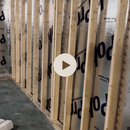Basement Insulation Detailing
Hello,
I am looking to finish my basement in climate zone 5A (Massachusetts) and get the insulation detailing correct.
1. I have glue foil faced EPS foam board to the foundation walls and taped the seams. Then framed a 2×4 wall infront of the EPS. Plan is to then fill those bays with unfaced R-15. Does this method seem acceptable?
2. In another part of the basement where there is a 4′ foundation wall (walk-out basement) then 2×6 framing on top of it. They have put unfaced insulation in the bays with 6mil poly stapled to studs. I have framed a full height wall infront of the 4′ wall so I wouldn’t see it in the finish. My thought would be to remove the 6mil poly and put kraft faced r-15 in the bay instead of sandwiching the poly in between two unfaced batts. On the 4′ foundation wall I have glued foil faced EPS to that and would think to use unfaced there (same wall assembly as described above)
Picture 1 is the first scenario
Picture 2 is the second. You can see what I am trying to describe on the left side of the image.
Any feed back on these two scenarios is greatly appreciated.
GBA Detail Library
A collection of one thousand construction details organized by climate and house part











Replies
Wytas,
Both your plans sound good. I'm not sure it makes much difference whether you use faced or un-faced batts in the double wall.
Thank you for getting back to me on this,
Rereading my O.P, not sure if it was that clear on scenario 2. For the 2x6 wall (double wall), could I leave the unfaced in the bay, remove the poly and put faced insulation in the new framed 2x4 wall from floor to ceiling?
-Or will the faced insulation and faced EPS create a double moisture barrier issue for the 4' section of foundation wall.
- Or does it not matter much being only 4' having the faced fiberglass and EPS.
Wytas,
Kraft faced batts are a class 2 vapour retarder. You can safely use them on both the bottom and top of the wall.
So then would it safe to use faced insulation in the 2x4 wall pictured in image 1? What class vapor retarder is the faced EPS?
The faced EPS is a class one. It's what is still called a vapour-barrier in our code.
I wouldn't use faced-insulation in the wall in image 1. I don't think it would do much harm, but the wall is safer without it. The wall in image 2 has some drying to the outside, and a class two vapour-retarder will help reduce the amount of moisture that gets into the wall.
Thank you for taking the time to answer my questions.
Good luck with your project.